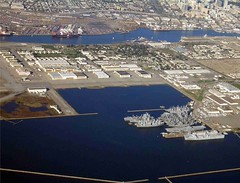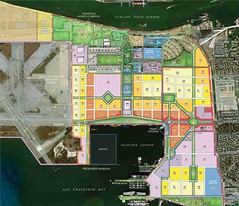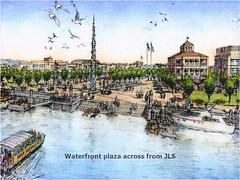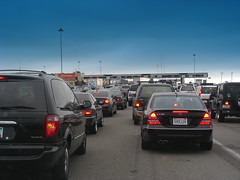Urban density is good, says Mother Jones; we agree, says Scientific American

Posted June 18, 2010 at 1:39PM
NIMBY opposition to smart growth is standing in the way of environmental progress, writes Josh Harkinson in Mother Jones.
As an example, he cites a proposed development in Alameda County, California, that would have added some 4,000 homes, none taller than three stories, on the 1,500-acre site of an abandoned naval air base now consisting largely of “concrete, landfill, and asbestos-stuffed warehouses.“ The new development would have had sophisticated environmental systems designed to save as much as 50 percent of energy consumption per person compared to conventional development, with energy coming from renewable sources, 25 percent generated on-site. It would have featured passive solar conditioning, geothermal heat pumps, and gray-water systems.
The site is in the center of the metropolitan area, entirely previously developed. Historic buildings would have been preserved, and 25 percent of the dwelling units would have been set aside as affordable housing. Moreover, there would have been 150 acres of parks, miles of trails, shops, and offices, along with sophisticated transportation features including dedicated ferry and bus lines to Oakland and San Francisco. The local chapter of the Greenbelt Alliance endorsed the project, says Harkinson, calling it "the epitome of smart growth."
Readers of this site will note that 4,000 homes of various types on 1,500 acres is not remotely high-density. But, nonetheless, opponents organized against the project, which would have required an exemption to Alameda’s growth cap (“There shall be no multiple dwelling units built in the City of Alameda . . . The maximum density for any residential development within the City of Alameda shall be one housing unit per 2,000 square feet of land"). The amendment was put to voters, who rejected it by an overwhelming 85-15 margin. Opponents had argued that, instead of housing, the site should be used for green industry: “a wind farm, a solar power plant, a factory for the electric carmaker Tesla Motors, and an ‘ecobranch’ of the cash-strapped University of California.”
I do not know the Alameda project personally, though I have read the public planning documents quickly. I can't say what its true benefits and costs would have been although, in general, the Greenbelt Alliance and I see things very much the same way. In any event, beyond Alameda, Harkinson is clearly right in making a more general point that urban infill and density are essential to a sustainable future:
“Fighting local growth can undermine the larger environmental values that many NIMBYs believe in. By 2050, the United States can expect to add as many as 200 million people. Demographers predict that they'll require 90 million houses and 140 billion square feet of office and other nonresidential space—the equivalent of replacing all the country's existing buildings. If we keep building in the way we do now, suburbs will gobble up a New Mexico-size amount of open space in the next 40 years. More suburbs mean more freeways and more cars, which means that by mid-century, Americans will clock 7 trillion miles per year—twice as much mileage as we do now. The alternative to this metastasizing, car-dependent sprawl is population density. And that means squeezing more people into cities and inner suburbs like Alameda. According to the Greenbelt Alliance, the Bay Area could absorb another 2 million residents by 2035 without expanding its physical footprint.”
Harkinson probes the roots of environmentalists’ distrust of urban development, citing Thoreau and Muir. He continues:
“Determined to make cities more livable, environmentalists have promoted parks and public transit, fought freeways and factories, and portrayed developers as the ultimate bad guys. But these well-intentioned efforts to curb the Robert Moses-style excesses of urban development had unintended consequences. Strict limits on building height and attempts to squeeze ever-larger concessions from urban developers (but not suburban ones) drove up the cost of housing in many cities—sending builders and home buyers looking for open space . . . SunCal developer Pat Keliher says that many of his colleagues simply avoid the cost of battling urban skeptics by building on out-of-town farmland: 'It's the old adage—cows don't talk.'"
Being harder on urban development than on suburban subdivisions has been environmental organizations’ worst fault, in my opinion. I am all for doing everything we can to soften the environmental impacts of urbanity. But the impacts of car-dependent suburban environments are far worse in almost every respect, when considered on a per-capita basis. That doesn’t mean we shouldn’t have suburbs, along with cities: it means we should build them better. And it means that our regulatory structure and policy incentives should be structured in a way that encourages rather than penalizes infill and compact, walkable city neighborhoods. More environmental organizations must speak up about this, and oppose NIMBYism that seeks to block sensible, walkable urbanism. Harkinson’s article is a good one and may be accessed here.
Writing in Scientific American, William Rees doesn’t mince words:
“The sprawling North American city in particular is a product of the cheap energy and profligate consumption of a materially exuberant age that is rapidly coming to an end. Cities may well confront a triple specter of climate change, scarcity of energy and resources, and broken supply lines . . . Today’s land-grabbing, auto-dominated, fuel-inefficient metropolises have evolved into parasitic black holes, sucking in excessive megatons of energy and materials from all over the globe and spewing out volumes of (often toxic) waste.”
Rees agrees that compact urban neighborhoods are key to the solution:
“Climate science indicates that to have even a chance of avoiding a catastrophic increase in mean global temperature, the worldwide economy must be largely decarbonized by 2050. The [National Intelligence Council] argues that the U.S. should actually complete its transition by 2025. Such goals pose an unprecedented challenge to urban authorities at all levels.
“To begin to meet that challenge, state and municipal governments must create the land-use legislation and zoning bylaws that urban planners need to consolidate metropolitan areas and smartly raise their density.”
Rees explains that, although our solutions must begin with urban densities, they can’t end there. He urges that, in addition to walkability, mixed uses, more advanced recycling, and co-generation in heating and cooling systems, “urban designers must rethink cities as complete ecosystems. The most resilient option might be a bioregional city-state in which a densely built-up core is surrounded by supportive systems.” The proposition is expanded somewhat in the full article, here.
Move your cursor over the images for credit information.





